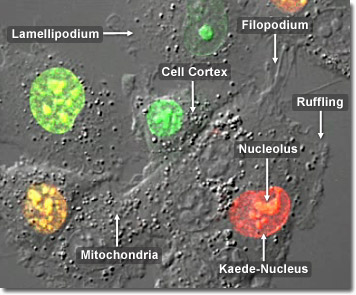Nearly all the DNA in a eukaryotic cell is sequestered in the nucleus, which occupies about 10% of the total cell volume. This compartment is part of the nuclear envelope which is formed by two concentric lipid bilayer membranes that are punctured at various intervals by large nuclear pores, which transport molecules between the nucleus and cytosol. The nuclear envelope is directly connected to the extensive membranes of the endoplasmic reticulum. The nuclear envelope allows the many proteins that act on DNA to be concentrated where they are needed in the cell. It also keeps nuclear and cytosolic enzymes separate, a feature that is crucial for the proper functioning of eukaryotic cells. In the digital video presented above, normal baby hamster kidney fibroblast cells (BHK line) are expressing a fusion of Kaede fluorescent protein to a nuclear targeting signal peptide.
Video 1 - Run Time: 06 Seconds
Video 2 - Run Time: 09 Seconds
Video 3 - Run Time: 09 Seconds
Video 4 - Run Time: 05 Seconds
Video 5 - Run Time: 08 Seconds
The nucleus performs two crucial functions for the cell. First, it carries the hereditary information for the cell, the instructions that determine whether a particular organism will develop to become a Paramecium, an oak or a human—and not just any Paramecium, oak, or human, but one that resembles the parent or parents of the particular, unique organism. Each time a cell divides, this information is passed on to the two new cells. Second, the nucleus exerts a continuing influence over the ongoing activities of the cell, ensuring that the complex molecules that cells require are synthesized in the number and of the kind needed. In the digital video presented above, normal baby hamster kidney fibroblast cells (BHK line) are expressing a fusion of Kaede fluorescent protein to a nuclear targeting signal peptide.

A prominent structure within the nucleus is a sub-organelle known as the nucleolus. One of its main functions is the production and assembly of ribosome components such as RNA and proteins. The nucleolus is roughly spherical and is surrounded by a layer of condensed chromatin. No membrane separates the nucleolus from the nucleoplasm. The size of the nucleolus reflects the number of ribosomes that the cell is producing. Its size therefore varies greatly in different cells and can change in a single cell, occupying 25% of the total nuclear volume in cells that are making unusually large amounts of protein. In the digital video presented above, normal baby hamster kidney fibroblast cells (BHK line) are expressing a fusion of Kaede fluorescent protein to a nuclear targeting signal peptide.